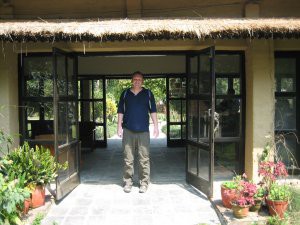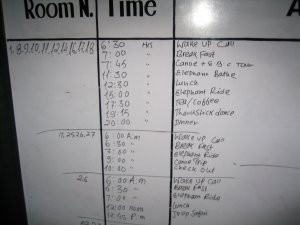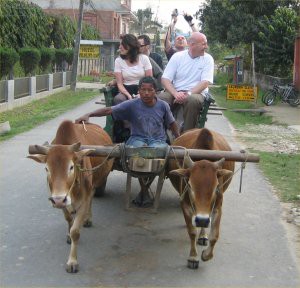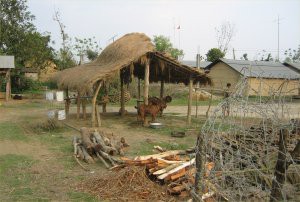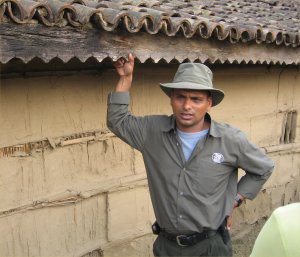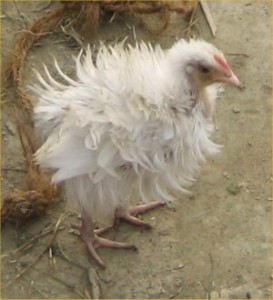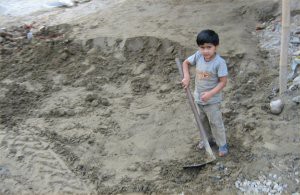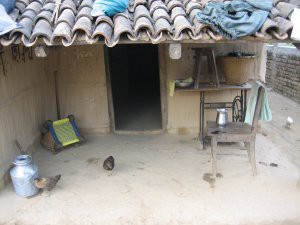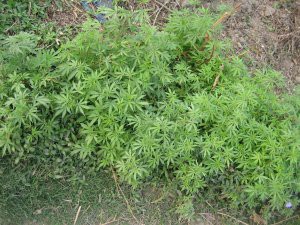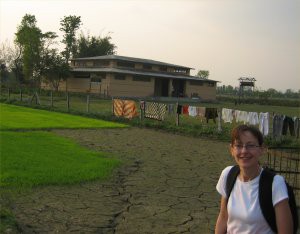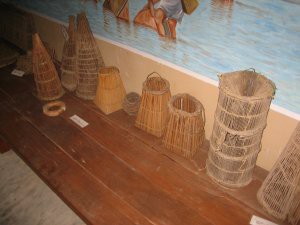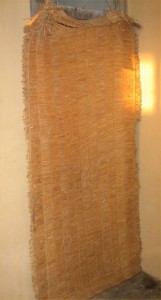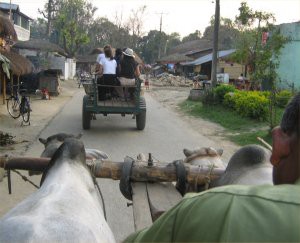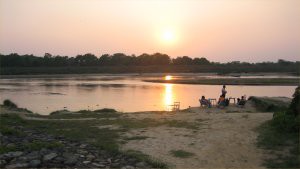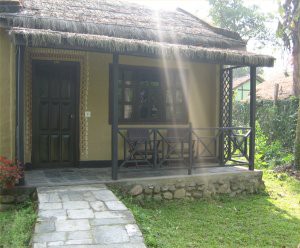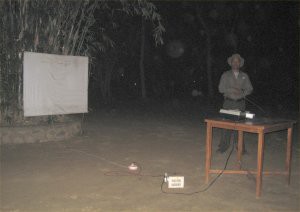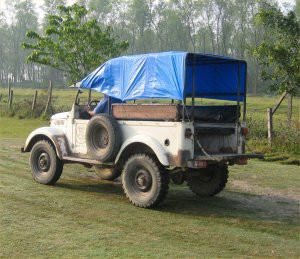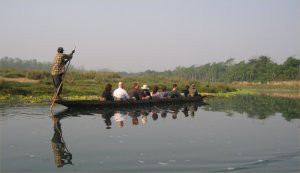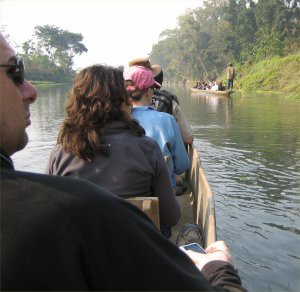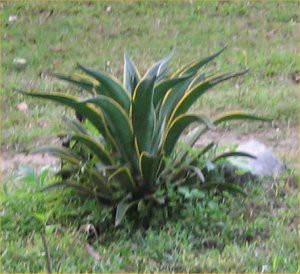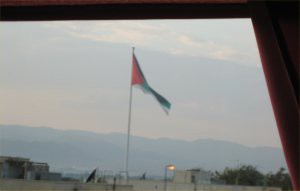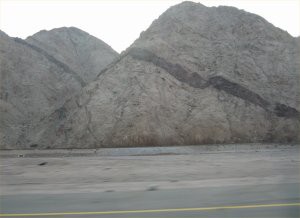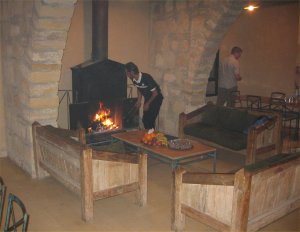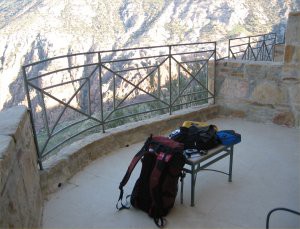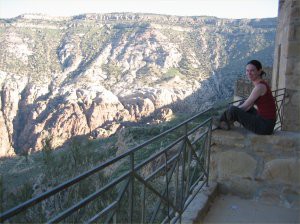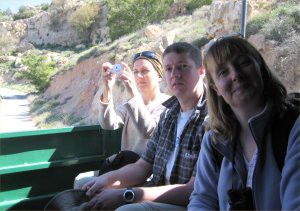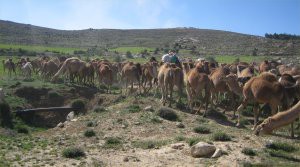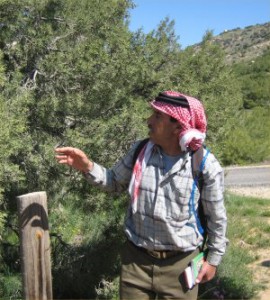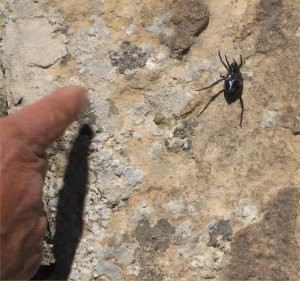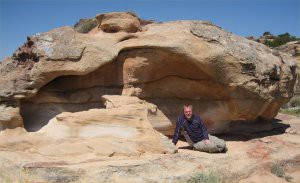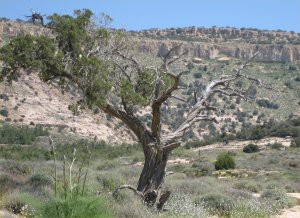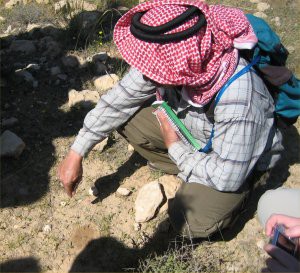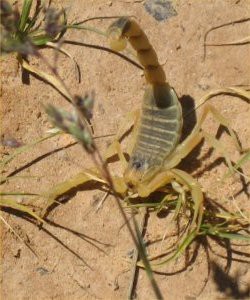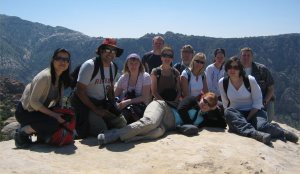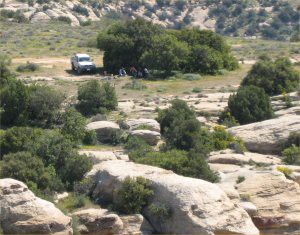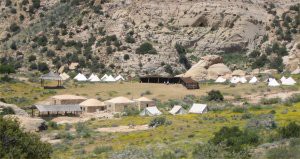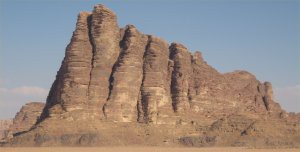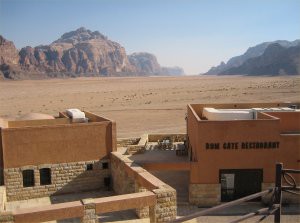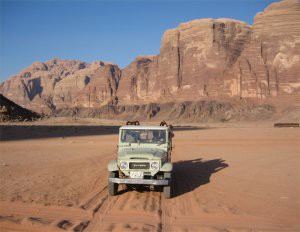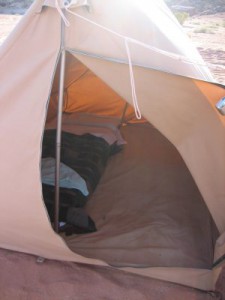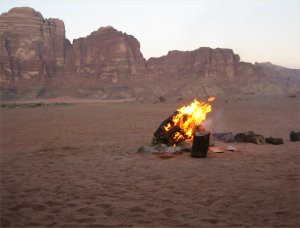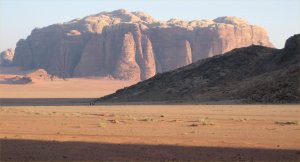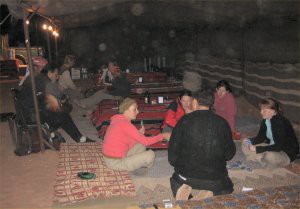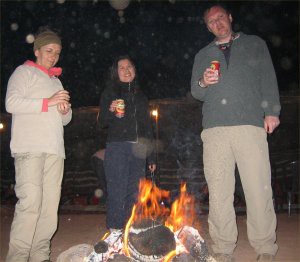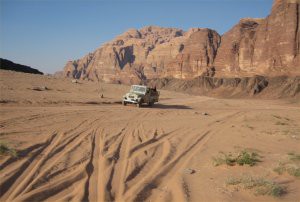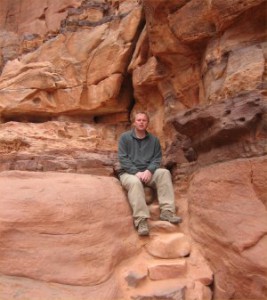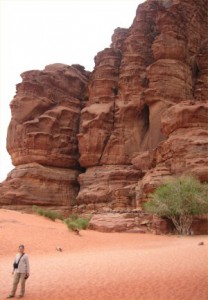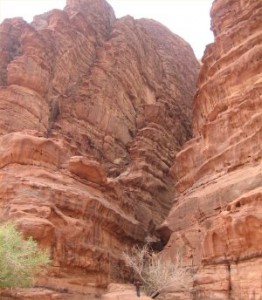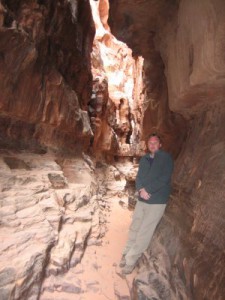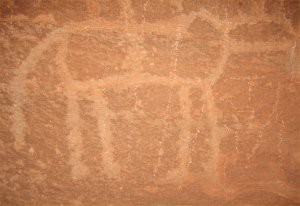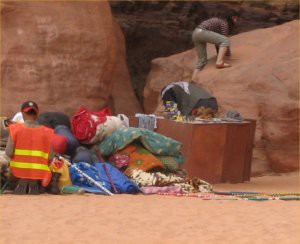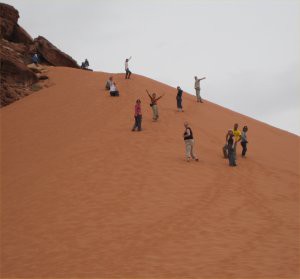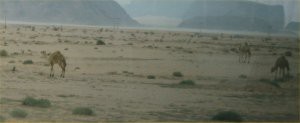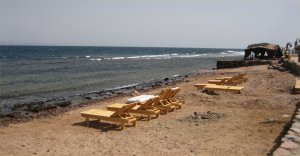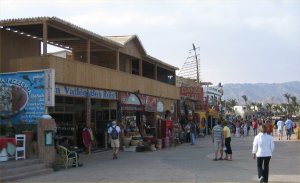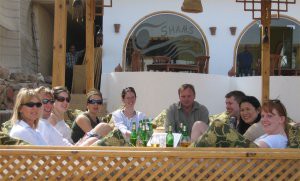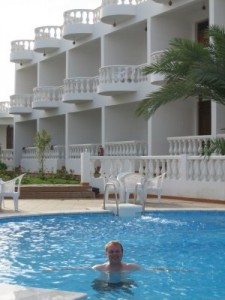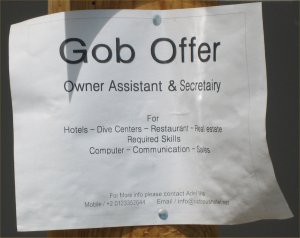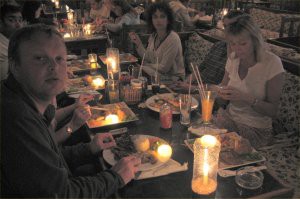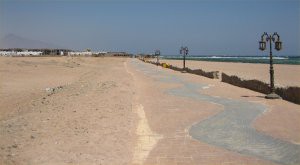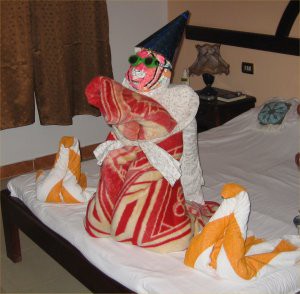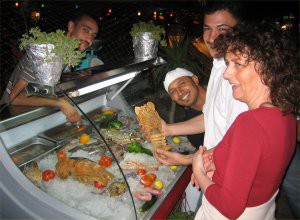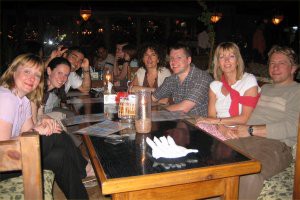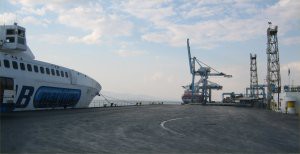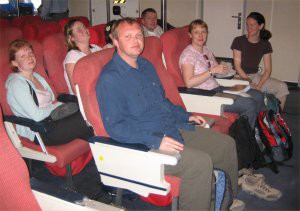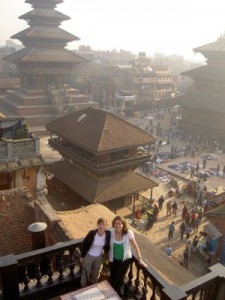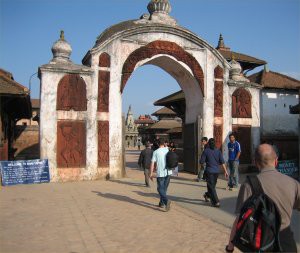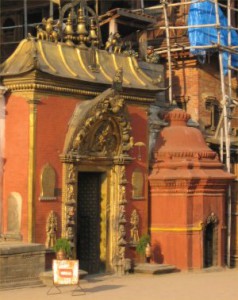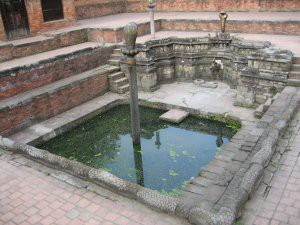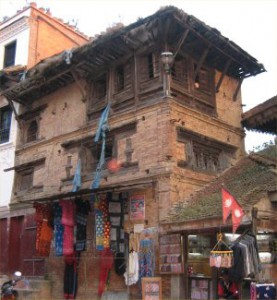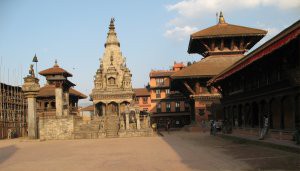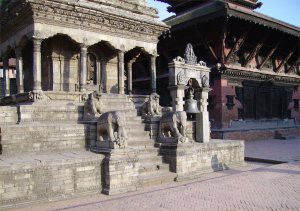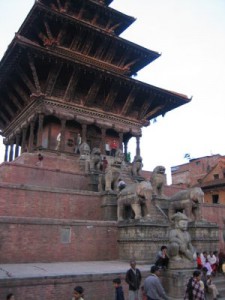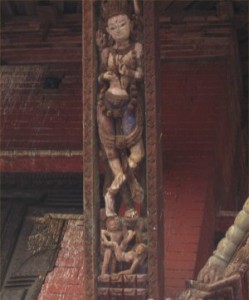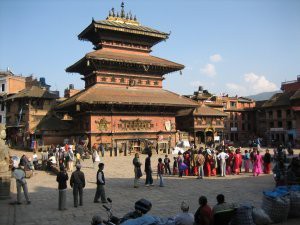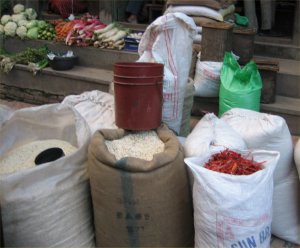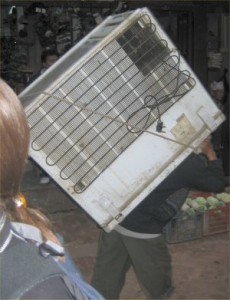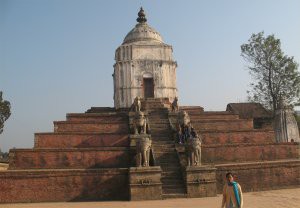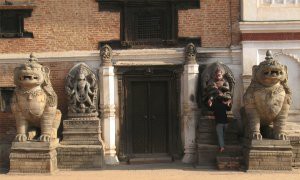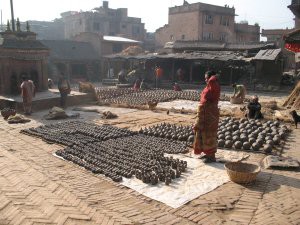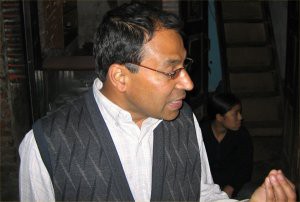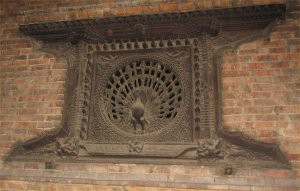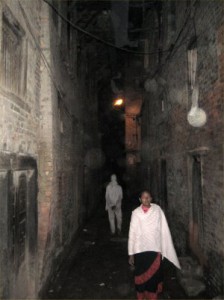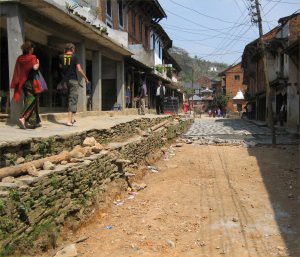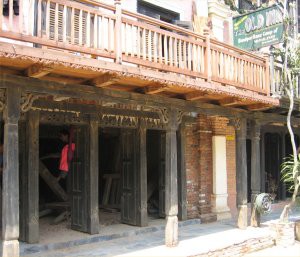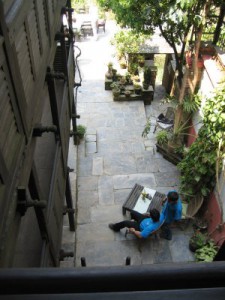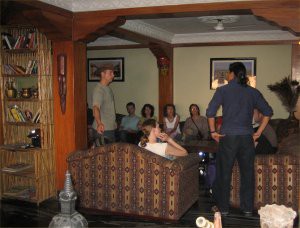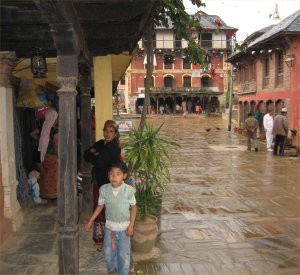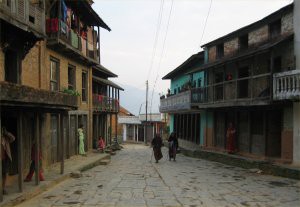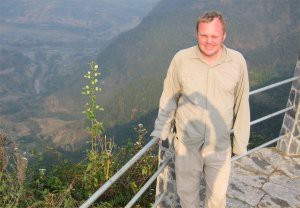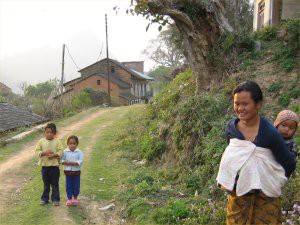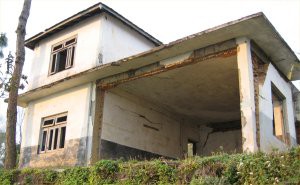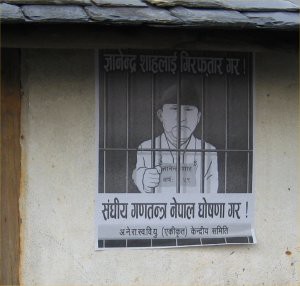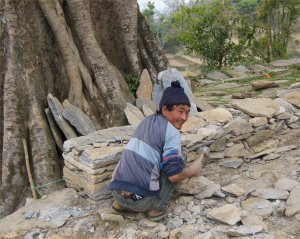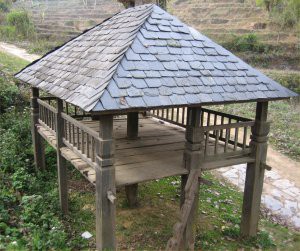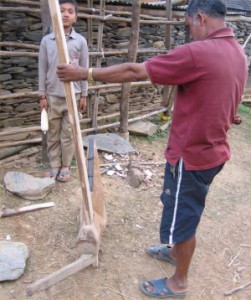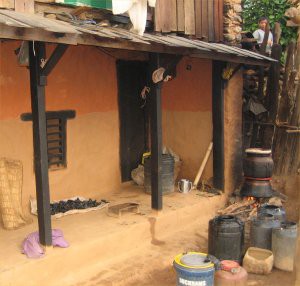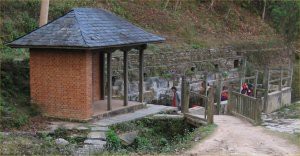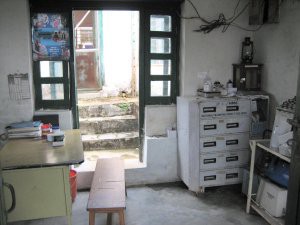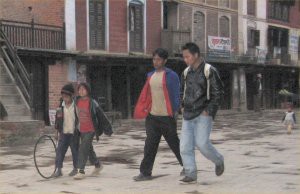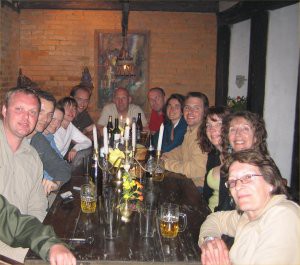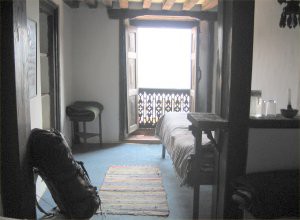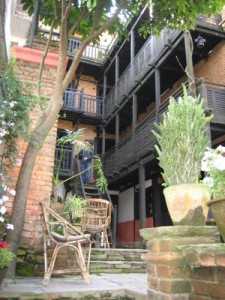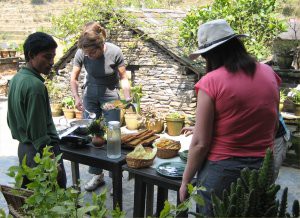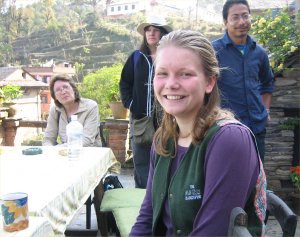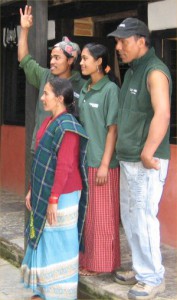Month: March 2004
Tour of Egypt and Jordan – Petra
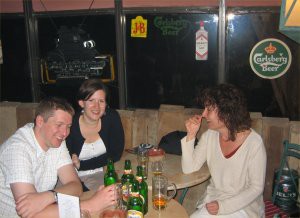 |
We arrive at Wadi Moussa, the nearest town to Petra.
The trip had been exciting to this point, but this was different. Years before, my friend Yvonne, had returned from a trip around the world (in those days, I wasn’t at all inspired by travel, but I was excited for her). I had met her in a cafe in Glasgow, and she had shown me some of the pictures from her trip. One photo, was of the Treasury in Petra. It had left a mark on me, for nearly 20 years and the following day, I would finally get to see it. The hotel we stayed in, had the ubiquitous “Irish” bar, but although anything but authentic, it was actually quite a nice pub. In the picture are Ben, Nicola and Sue, who I got on with really well. |
| The tourist shops near the entrance, draw heavily on the fact that the treasury was used in the film Raiders of the Lost Ark.
It was voted as one of the new seven wonders, and 800 of its monuments are listed is Unesco world heritage sites. Petra gets its title “The Red Rose City” from a poem by John William Burgon. The last 2 lines are “Match me such a marvel save in eastern clime, A Red Rose City half as old as time“. Problem is, when he wrote the poem, he hadn’t actually been to Petra, 16 years later, having seen it, he wrote to his sister commenting “There is nothing rosy about Petra, by any means”. |
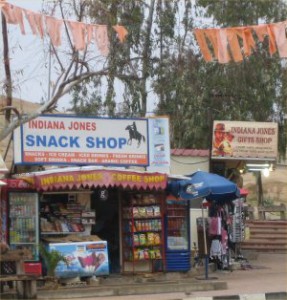 |
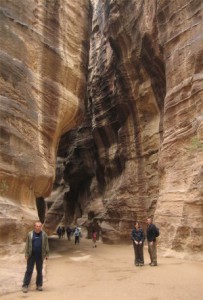 |
Horses are used to drive carriages into the city (I cant imagine why anyone wouldn’t want to walk into it, and savour the experience, but up to them.)
There is an animal sanctuary nearby, where these horses are looked after once retired. The long-hidden site was revealed to the Western world by the Swiss explorer Johann Ludwig Burckhardt in 1812. The City is 2000 years old, built by the Nabateans, it has also been occupied by The ancient Romans and the Bedouin. The eastern entrance leads steeply down through a dark and narrow gorge (in places only 3–4 meters wide) called the Siq (the shaft), a natural geological feature formed from a deep split in the sandstone rocks and serving as a waterway flowing into Wadi Moussa. |
| Along the sides of the Siq, are these channels, which at one time provided running water, and also a “safety valve” during flash flooding. It used to be covered, but long ago ancient floods washed away the cover stones.
Excavations have shown it was the ability of the Nabataean’s to control the water supply that led to the rise of the desert city, in effect creating an artificial oasis. Archaeological evidence demonstrates the Nabataeans controlled these floods by the use of dams, cisterns and water conduits. Thus, stored water could be employed even during prolonged periods of drought. |
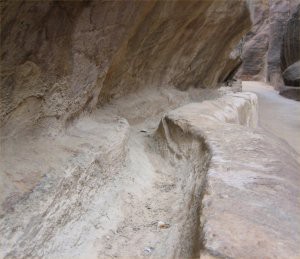 |
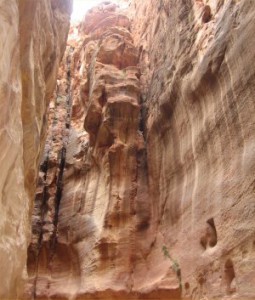 |
In this picture, you can see just how high, the walls of the Siq go (the bottom of the picture starts at about 50 meters). |
| At the end of the narrow gorge stands Petra’s most elaborate ruin, Al Khazneh (“the Treasury”) hewn directly out of the sandstone cliff.
For the fascinating details of how it was restored, click here. The Treasury’s original purpose remains elusive – except that it was not a Treasury. Some scholars believe it was a royal tomb, with the king’s burial place in the small chamber at the back; others, a temple, pointing to its temple-like façade and the lack of burial holes – for them the rear chamber was the sanctuary, complete with ritual ablution basin. Little has changed the Treasury since the Hon. Charles Irby and Mr. James Mangles, commanders in the British Royal Navy, described their first sight of it in 1818. “We do not know with what to compare this scene”, they added; “perhaps there is nothing in the world that resembles it”. |
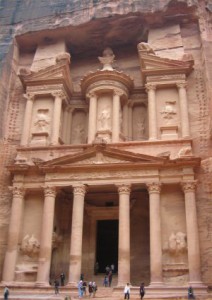 |
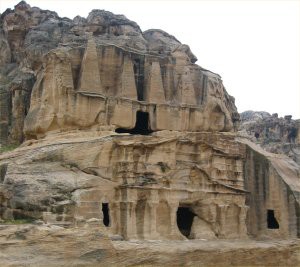 |
The Obelisk Tomb and Bab al Siq, Petra.
It takes its name from the four Indian Obelisks along the top. |
| The locals, didn’t waste any resource.
Here, a carved out room, was used to “house” a donkey, temporarily not needed to pull carts down through the Siq. In times gone by, a Bedouin family would have lived here. |
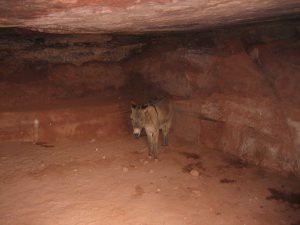 |
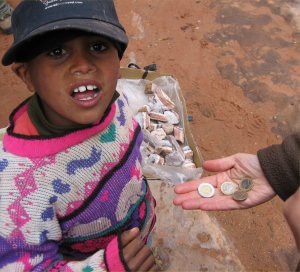 |
This child was wandering around, giving out Euro coins.
We worked out, that he actually wanted them changed into some kind of usable currency. We exchanged them for Dollars, in return for allowing us to Photograph him. |
| Some of the souvenirs, were a bit sublime (one shop was selling used, dead batteries).
I was intoxicated by the moment, and ended up spending more than £100 on presents and souvenirs (I was so happy to be there, I didn’t even bother negotiating). One thing I quite liked (couldn’t work out how to get it home) was this miniature Bedouin tent. |
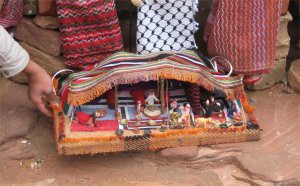 |
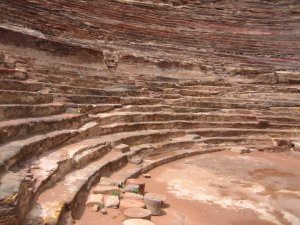 |
The amphitheatre has actually been cut into the hillside and into several of the tombs during its construction.
Rectangular gaps in the seating are still visible. Almost enclosing it on three sides are rose coloured mountain walls, divided into groups by deep fissures, and lined with knobs cut from the rock in the form of towers. Theatre, which was constructed in the early 1st century AD by Nabataeans and enlarged and improved by the Romans shortly after their annexation of the Kingdom in 106 AD. This they did by ruthlessly gouging away a street of houses or tombs in order to extend the rear of the auditorium, which could then accommodate 3000 people. |
| Elsewhere in the City, was this Byzantine Church.
The floor had been re-constructed to show how it would have originally looked. |
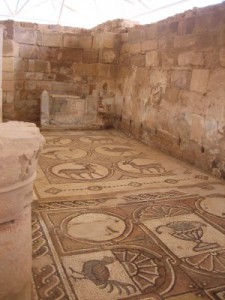 |
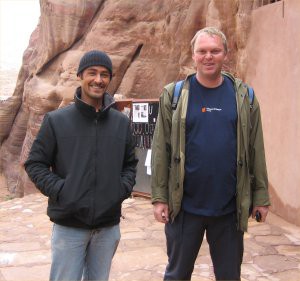 |
For some reason, I look like I am missing one of my teeth in this picture. I am not.
While travelling in Jordan, I had been reading “Married to a Bedouin”, the story of Marguerite van Geldermalsen, who visited the city while travelling (There was no internet or stuff like that, seeing the world in 1978 wouldn’t have been easy), married and fell in love with a souvenir seller, and lived with him in a 2000 year old cave. As I wandered around Petra I could here a distinct New Zealand accent, coming from one of the locals. I was delighted to meet Marguerite’s son Raami, who still carried on his fathers business (Mohamed, sadly died in 2003). There is a photo in the book, of a young Raami, in a red high chair, his father constructed. The first thing I said to him was “you’ve met the Queen” ((I knew from the book that Queen of Elisabeth II and Queen Noor visited Petra in 1984). I knew it was really him, as he replied yes, but I was asleep. We had a friendly chat, and he talked about his parents (it was a rare occasion, where I shut my mouth and let someone else speak !). I gave the space pen I had carried around the world to him, and asked him to give it to his mother. I told him that she was an inspiration to me. |
| Although there are no longer any permanent residents in Petra (which explain the restaurant and modern toilet facilities in this picture), you can still see the cave where Marguerite lived with her family.
Its in the middle of the picture, slightly to the left. |
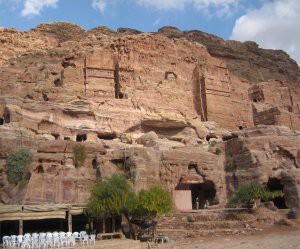 |
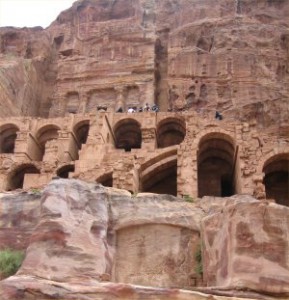 |
Urn Tomb.
You can see how the caves were carved, one above the other, in places 4 stories high. The Urn Tomb was probably constructed around 70 AD. It is preceded by a deep courtyard with colonnades on two sides. High up in the facade there are 3 niches which lead on to small burial chambers. Their inaccessibility would have made them relatively safe from tomb robbers. Inside there is a massive single chamber which may originally have served as a triclinium for funerary banquets, but which was adapted in 446 AD to serve as a Byzantine church, the vaults of which can still be seen below the tombs. |
| Front of the palace tomb. | 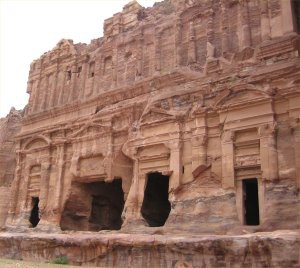 |
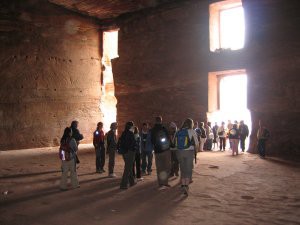 |
Inside the palace tomb, was this enormous room.
How long must it have taken to chisel all of this sandstone out, and how, with primitive technology and tools, did they get the walls so straight. |
| 2000 years of high winds have eroded Petra’s sandstone, to create this effect.
This is a classic Petra “hole in the wall” shot, featuring my friend Gill. |
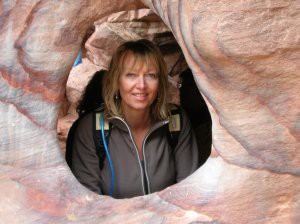 |
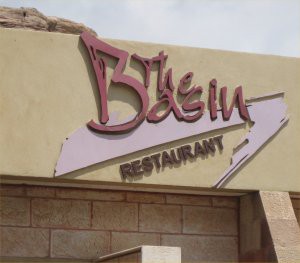 |
We go to the Basin restaurant for lunch.
Long before the residents were moved from Petra, the Basin, was the only Hotel in the area, and was featured extensively in Married to a Bedouin. The Petra museum was right near here. Okay it was interesting, but I couldn’t help wondering what the point was, when you are actually in Petra. Perhaps a Petra museum in Manchester would be more appropriate :). |
| We head up to the Monastery.
Sue poses next to the striking rock, with a view back down to Petra behind. |
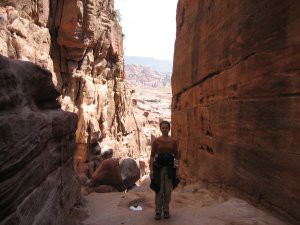 |
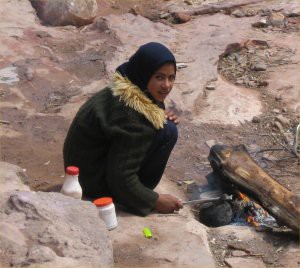 |
This Bedul girl was selling souvenirs, and was preparing some Tea for herself on an open fire.
As I have said before, it always inspires me, when I see people using Bushcraft, which to me is a hobby, and to them, just a normal part of daily life. The Bedul are a small tribe of Bedouin who used to live in the caves in Petra until 1985. They farmed in the area and had their goats graze there before being expelled and re-housed in the village of Oum Seyhoun on the edge of the archaeological park. Now most of them make a living from tourism, renting horses or selling trinkets. |
| As we walked up the hill, we pass through this naturally occurring “doorway”. | 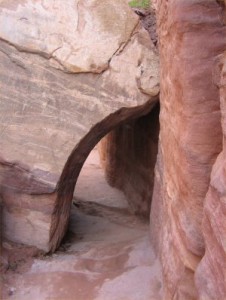 |
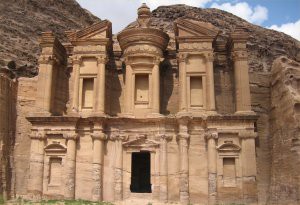 |
The Monastery.
Petra’s largest monument, dates from the first century BC and was dedicated to Obodas I. The monument is known locally as Ad-Deir, and like the Treasury, probably wasn’t a Monastery. To get an idea of its size, the doorway, is 8 meters high. |
| An enterprising entrepreneur, has converted the cave opposite into a cafe (the Monastery is 200 meters above Petra, and nearly an hours walk from the Basin restaurant). | 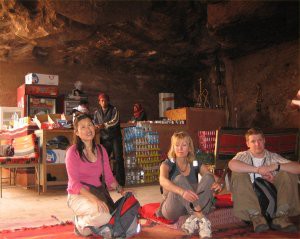 |
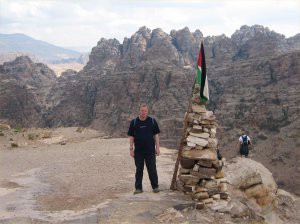 |
To the North of the Monastery, is this plato, with astounding views of Petra and the mountains around. |
| Having spent the day in Petra, we are given free time.
I spend the next 2 hours, walking slowly back to the hotel. The danger in situations like this, is that the expectation of seeing something might be greater than the reality (I’m thinking of Kathmandu and Prague) but this wasn’t the case. Was it worth the 20 year wait ?. Most definitely. |
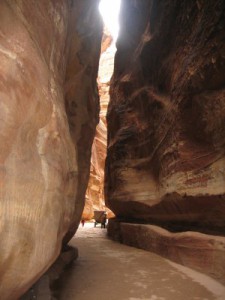 |
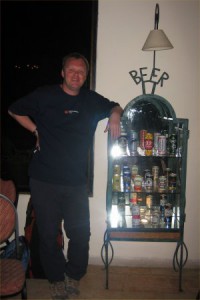 |
Petra was not surprisingly, the last destination on the Pyramids to Petra tour.
By now my reputation had got around the group, and as a farewell, I was invited to pose in front of this cabinet with several different beer cans in it (the significance was not lost on me). When I arrived back in London, Ralph and Aud gave me a lift, all the way back to Liverpool, which saved me about 8 hours of the day, and I would just like to say thanks. |
Tour of Egypt and Jordan – The Dana National Park
Tour of Egypt and Jordan – The Wadi Rum.
Capetown and the Garden Route. Finale of the Bluelist (3/3).
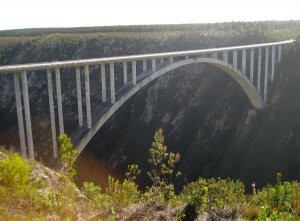 |
Up early, we drive to Blukrans bridge (a spectacular feat of engineering)Its the largest single span arch bridge in the world.People were saying at the time, it was the highest bungee jump in the world. Its actually the 3rd, the Macau Tower is the highest at 233m (but only 16m higher).
I watch some lunatics jump of the bridge and it turns my stomach. |
| I decide to do the 2nd of the “must do’s” for the Garden Route and try some Mitchell’s beer.I wander over to the Cliffhanger pub and order a pint.The barman is the most miserable barkeep I have ever met. I pay him 200 rand (you would think he was paying me, from the look on his face) and take my beer outside for this photo.
Turns out to be cask ale, which I don’t like. I swig half a pint, then give it back. Thoroughly disappointed, I head over to some stalls nearby to look at carved animals and cheer myself up. I buy a carved giraffe from some Zimbabwe traders, for 120 rand. Our guide explains that unemployment in neighbouring Zimbabwe has led its people to leave their homeland in search of work. This has affected employment ins South Africa significantly. |
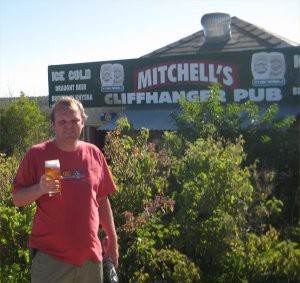 |
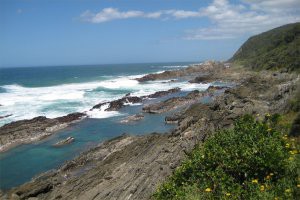 |
90 minutes later, and were at Storms river.We all set off to do the coastal walk. We cross a bolder field, and the ground is (obviously) quite uneven.A few people decide to not to continue, and for no particular reason, I decide to go with them.
We find a nice cafe, and I have the fish cakes I have been wanting to eat all week, along with 2 really nice cups of coffee (it was one of those sort of non adventure days, when I just felt like relaxing). I pop into the shop and buy a small carved black lion (my collection of hand carved African animals is growing). |
| There were some really nice chalets here, which some other Garden Route travellers were staying in. I wished we’d done the same.We headed out to visit the suspension bridge.The path through the Tsitsikamma National Park, was really relaxing and although steep in parts, was very even under-foot. | 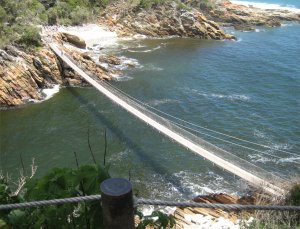 |
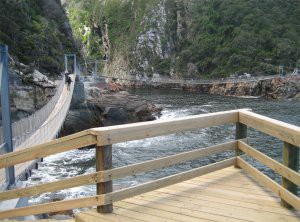 |
Turned out that there were several suspension bridges interconnected together.When I had crossed suspension bridges in Borneo, we were told to only cross, 1 person at a time. The sign next to these said no more than 25 people at a time ! |
| Next we travel to Cape Agulhas.This monument, marks the cape, the most southern point in Africa.My guidebook, said if you go swimming, swim on the left, as the Indian Ocean is warmer. In reality, it makes no difference.
I’ve said before, that SA people, are fairy straight up and no nonsense. Its here where the common phrase “you cant swim to 2 oceans” takes its name. It means simply, don’t sit on the fence. |
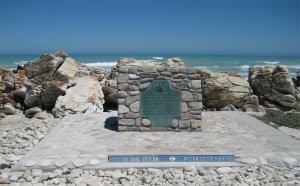 |
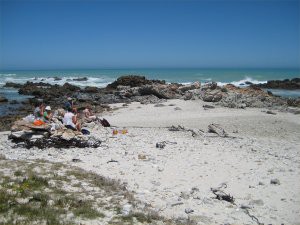 |
I was surprised how quiet it was. No souvenir shops, hotels, ice cream vendors etc.Its also one of a few places on earth, that has zero declination (if you know about navigation, that will mean something to you, if not read this). |
| Cape Agulhas, means literally Cape of Needles in Portuguese, as its filled with tiny coral shards. These have sunk around 250 vessels in the last 200 years.This lighthouse isn’t an old relic designed to look quaint, its actually fully functioning.It is reckoned to save thousands of lives every year as ships navigate the clipper route. | 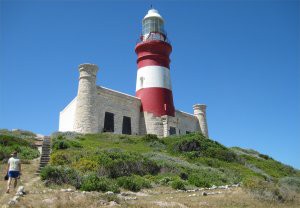 |
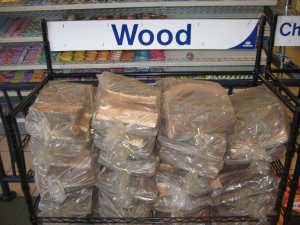 |
We continue driving to Hermanus and stop off for something to eat at a service station.You don’t see firewood, in many service stations in the UK.While here, I decided to buy a copy of FHM to read on the journey (I was a regular reader for 6 years, but went of it a bit. Since then its expanded, and there’s actually one written just for South Africa).
They haven’t lost their way, and the magazine was full of “take the piss” articles. It kept mentioning Oke’s. I Didn’t know what that meant, but Charl explained it was South African slang for mates. |
| We arrive at Hermanus, the number one location in the world, for watching Whales from land.I was delighted to find that we are staying at a hotel right on the waterfront, near Walker Bay.I put my rucksack into my room, and head out exploring.
There is a whale in the harbour. To me, it could be an old Tyre at that distance, but the locals recognise it by name. I sit looking out to sea, drinking a glass of lager, entertained by a xylophone player. |
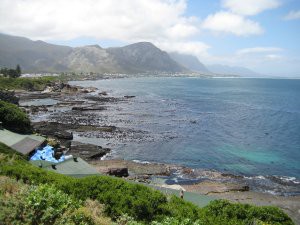 |
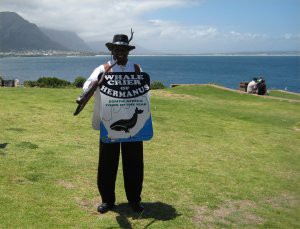 |
I see the famous Whale crier (a job unique in all the world, he blows his vuvusela when I whale is sighted (their common now, since the world cup, but it was the first time id seen (or heard one)).I try to photograph him, but some young South Africans with water pistols are causing him some discomfort and he beats a hasty retreat.He returns later, and I’m able to get this photo.
As much as traveling, is about trekking in Borneo and meeting tribesmen, its also about experiencing modern culture, which years from now may be discussed with significance. South Africa are due to play Rugby that afternoon. I find a bar to watch the game. Inside, there are several specific groups speaking privately. Xosa, Zulu, dozens of others I don’t know (there are 11 national language in SA) along with the 2 white tribes, British and Afrikaner. Then the match starts, and the pub just sort of merges into one unit (I’m not saying this out of romanticism, I saw it with my own eyes). Months after returning home, I would watch the film Invictus, which explained everything. Only sport can unify people in this way, after 400 years of separation and segregation. Its dark outside so I head back to the hotel. Hot chocolate and I watch Stargate Universe on my laptop. I find annoyingly, that one of the episodes has no sound. I watch it anyway and try to work out the plot from the pictures. |
| Next morning I’m up early for breakfast. They have everything you could want, but no crusty buttered bread !.A group walk is scheduled for the morning, and optional whale watching boat trip in the afternoon. I decide to opt out of both, and have the day to myself.I find a coastal path along the harbour. The Fernkloof nature reserve, cliff path, which I follow for several miles. Every now and then I venture off the path and explore the coastal rocks and vegetation.
Having set of early, I get back at 10:45. An organized tour of the town is scheduled for 11am, but only runs with a minimum of 2 people. With nobody else there, the very decent chap, refuses my offer of paying for 2, and recommends some key sites, and highlights of the towns 3 museums for nothing. |
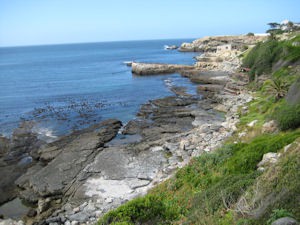 |
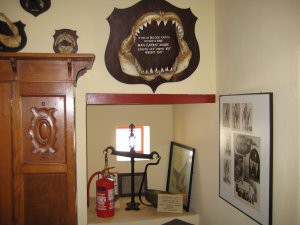 |
I visit the photographic museum first. There are loads of interesting pictures, but best of all, is a sharks mouth, from the record breaking lb2000 caught in the harbour by rod (not the name of the person who caught it !).In my teenage years, I had a job on the markets and carried 50lb bags of potatoes. When I think of how heavy that was, I wonder how the catch was even possible.Earlier that morning, I’ve seen some sea kayaks and go down to the shore to investigate. R300 for 2hrs.
Money has gone really well on the trip, but from experience, the day before going home, is the time when most people let their guard down and overspend (and sometimes end up sat in an airport with no money to buy coffee !). I continue exploring around the town and decide to get my hair cut. They seem quite surprised, but do a cracking job for R80, which I round up to R100. I pop to the cash point to reload and mentally calculating the exchange rate, I withdraw my cash. I realise that in my head, the decimal point was in the wrong place. Instead of £40, I have withdrawn £4, and paid £2.50 for the privilege !. |
| I go back and get the correct amount before making my way to the whale museum.Staff there are really laid back (receptionist is playing cards, on windows 95).The manager explains “Things are pretty formal in the week, but at weekends we don’t give a toss”. I’m growing to love the mannerisms of the Afrikaners.
There is a large whale skeleton, but its plastic. Some of the interesting exhibits make up for it. I debate buying a whale poster. The danger is always buying with the feel good factor, and then getting home and realising that you wasted time and money buying tat. When I buy something, its either put on display in my living room, or stored in a special box for memories, which I open each year on my Birthday and New Years day. I apply this to every souvenir, and if it wont fit into either of these 2 categories, then I simply don’t buy it. |
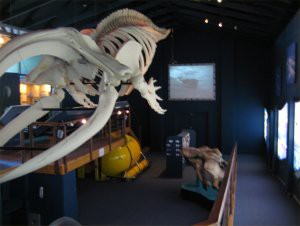 |
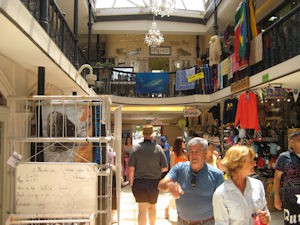 |
I continue exploring and find a boutique shopping mall (while looking for a life is good T-shirt, I don’t already have).I bump into the Ozmonds (the pet name I have found for a charming Australian couple in our group). They have both had their haircut as well !.I just cant find a carved black hippo that I really want to add to my collection of miniature animals. After much searching I find an enamel Zebra. |
| I go back to the hotel and get cleaned up, then head to the Fisherman’s Rest, where we are all meeting for our final evening out.The restaurant has a bar, I grab a bottle of beer and sit quietly in the corner.I think about the book that inspired this trip. The Courtney family, live at a place called Weltevreden (which I have mispronounced for 20 years). It means simply – well satisfied. I decide that’s how I’m feeling.
One thing about me, is that when I’m completely relaxed, I sort of shut down, and people who don’t know me, think I’m miserable, when the total opposite is true. The owners jokingly bullied me into having a 2nd photo taken (which you can see by moving over this one) with me smiling. The staff are friendly and good humoured, with an astute knowledge of foul language. I order Steak medallions, the meal is quite delicious. Afterwards we go to a bar called the Zebra crossing. Our waiter joins us and insists on buying everyone a drink !. |
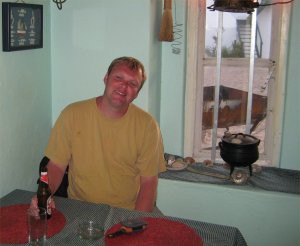 |
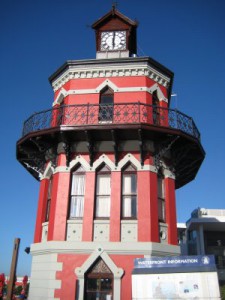 |
The next day we drive back to Capetown to the V&A docks, with the intention of visiting Robben Island.As we wander around, I recognise the famous red clock. What isn’t widely known, is that it incorporates a quirky mechanism to measure tidal levels.Its a beautiful day, and a leg of the round-the-world yacht race is being run from here. |
| I continue wandering (the boat doesn’t leave for 45 minutes).Away from the bustle of shoppers, amongst a crop of Carob trees, is Nobel Square with Table mountain behind it.It features statues of South Africa’s 4 Nobel Peace Prize Winners.
Most people can name the obvious 3. Nelson Mandela and F W De clerk won it jointly, and Archbishop Desmond Tutu. The 4th, is Albert Luthuli a former leader of the ANC. |
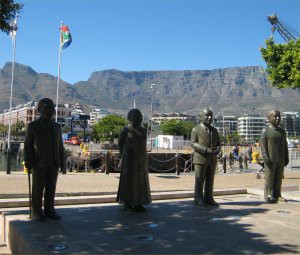 |
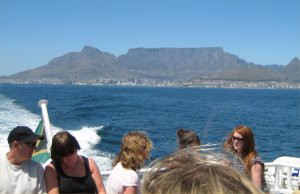 |
We board the Catamaran for Roben Island. It takes about 40 minutes and I find myself talking to a couple about Hitler.As we travel over, Table mountain is behind us. Its only 8 days since I climbed it, but it feels so long ago now. |
| As we disembark, there was a plaque:While we will not forget the brutality of apartheid, we will not want Robben Island to be a monument to our hardship and suffering. We would want Robben Island to be a monument … reflecting the triumph of the human spirit against the forces of evil. A triumph of non-racialism over bigotry and intolerance. A triumph of a new South Africa over the old.We are shown to 3 buses and given a tour of the island. | 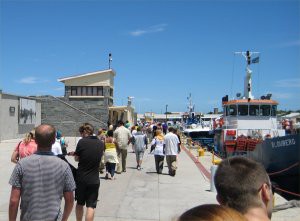 |
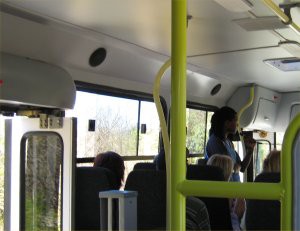 |
Our guide is charming and well informed. He explains that the Island was originally a leper colony.He comments that calling lepers, lepers, is wrong, as it brands them as though they asked for the disease.He shows us the house of Robert Sobukwe the leader of the Pan Africanist Congress. He explained that Sobukwe had been detained without charge for 6 years after his sentence ended.
He gave an explanation of the group areas act and how the “dompass” permit system was used to control non-whites during apartheid. |
| The prison complex looked a lot more civilised than I had expected, but it was explained that everything changed after 1977 when photo’s of the conditions were smuggled out by the Red Cross. | 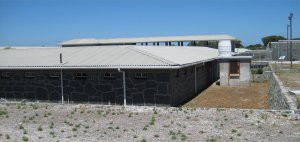 |
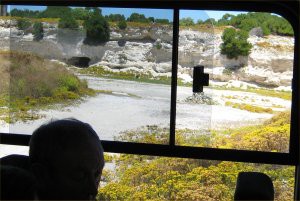 |
The Lime quarry where inmates were made to mine (it had a serious effect on their health.On the top left of the picture, is the Lime cave. It was used as a lecture theatre to share information about the armed struggle.The prison guards never bothered to check what went on inside, they presumed the the inmates used it as a toilet. |
| We are introduced to a different guide, who explained what daily life was like, food exercise etc.He explained that ordinary criminals had tv and then said simply “our” news was recorded from the radio, so it could be censored.It was obvious that he had been an inmate here as a teenager. | 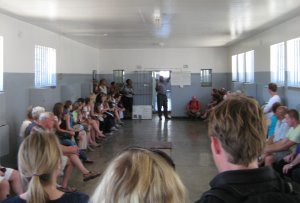 |
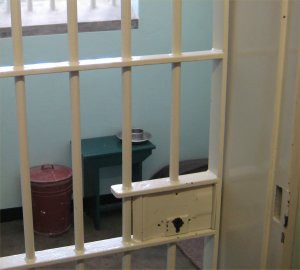 |
Nelson Mandela’s cell, with the stool he made himself. Its about 4 foot by 8.I started thinking of Mandela’s favorite poem Invictus, that would inspire a film, some months later.Out of the night that covers me, Black as the Pit from pole to pole, I thank whatever gods may be For my unconquerable soul. In the fell clutch of circumstance Beyond this place of wrath and tears It matters not how strait the gate, William Ernest Henley |
| Nelson Mandela’s Garden, where his book The Long Walk to Freedom was written.We walk back to the Jetty. I feel a bit down again. My flight home is in a few hours and I don’t know what’s waiting for me when I get back.Will I find another job in time or will I lose my home ?. Will I have to give up working in IT and leave the vocation I love ?.
Its then that it occurs to me. Nelson Mandela lived here for 19 years. He must have looked across the water to the mainland and dreamed every day of simply going home. I decide to stop being selfish. Inspired by my surroundings I reach inside myself and find my determination. I climb onto the deck of the Catamaran, taking the first steps home. Everything is going to be okay. |
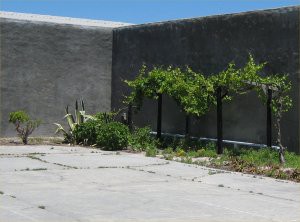 |
Capetown and the Garden Route. Finale of the Bluelist (2/3).
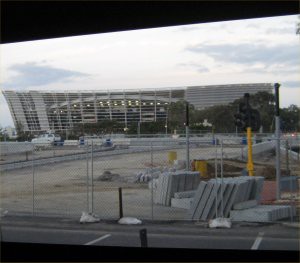 |
The world cup was still several months away, and the stadium at Green Point in Capetown was under construction (the previous stadium had been demolished in 2007).
I really wanted South Africa to win, in the same way that they did in the Rugby world cup, 15 years earlier (the events are shown in the film Invictus). Sadly that didn’t happen, but loads of people had a good time visiting the country and Vuvuzela has become a household word !. |
| On our way to the Stellenbosch wine lands, we stop of at the Kirstenbosch. Although his main home is in London, Wilbur Smith owns a house here.
On the eastern slopes of table mountain, it covers over 36 Hectares and is one of the most spectacular gardens of its kind, in the world. Kirstenbosch, the most beautiful garden in Africa. |
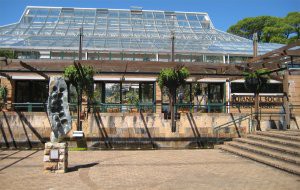 |
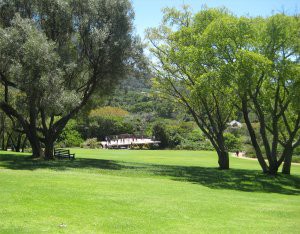 |
It isn’t just for frumpy botanists and gardening types. Just like the botanical gardens in Sydney its designed to reach out to everyone.
As I set off walking around, I saw this stage being erected for a music festival. I headed up hill, along Rhodes drive, to get a better view of the whole park. |
| There were many specialised sections like medicinal plants, mountain flowers and stuff like that.
There was a mixture of open spaces and more secluded paths like this one. I only had 3 hours to see it all, and I didn’t want waste a minute. |
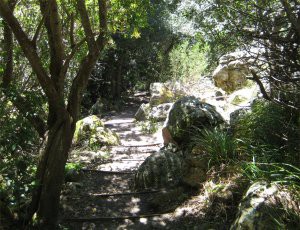 |
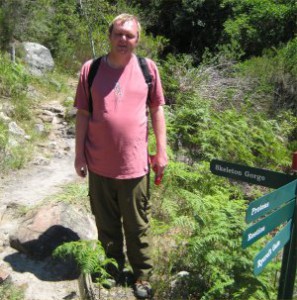 |
I walked along a section of the Skeleton Gorge path.
Jan Smuts walked this rout most days, well into his 70’s and I was proud to have walked in his footsteps. |
| Henry Pearson, the designer of the gardens is buried here.
On his grave it says simply “If you took the time to find this grave. Look around.” We left the gardens and headed for Stellenbosch. We spent the night in an Afrikaner home. There was a large organ in the living room, and black and white photo’s of the owners ancestors, going back to the first Dutch settlers. These were the people that Smith wrote about in all his books and I feel like I’ve come home (even though I’m on the other side of the world). There was a bible next to every bed in the house, and for the first time in some years, I found myself reading it before drifting off to sleep. |
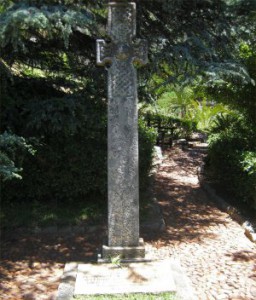 |
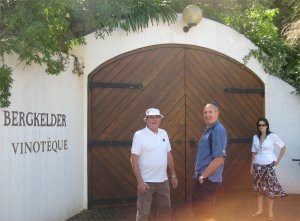 |
Stellenbosch is known internationally for its wine and we had a full morning planned experiencing it.
Our first stop, was the Bergkelder. Here, they don’t grow grapes but buy them. They are made into wine and stored inside a hollowed out mountain. Our guide Lientjie was really helpful and friendly. She was obviously from Afrikaner stock. Power of the Sword (the Wilbur Smith novel that had inspired my trip) was set around the 40’s and 50’s and mentioned that it was very rare for British and Afrikaners to inter marry. I asked our guide Charl if this was still the case. He said that doesn’t really happen any more, South Africa is a truly multicultural country, not just in law, but in attitude. |
| We went into the mountain and saw some of its famous carved barrels from 1969.
We tried 5 different wines. We had eaten a small breakfast and no lunch, so the cold dark corridor, came alive with giddy laughter. I’m quite new to wine tasting. Each time Lientjie would discuss the smell and taste of the wine. This was quite strange as it always seemed familiar, but I couldn’t think of what. Then she would say common associations are dark chocolate, ripe banana or cigar box and I would instantly connect. |
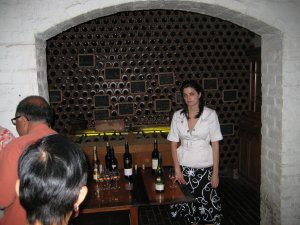 |
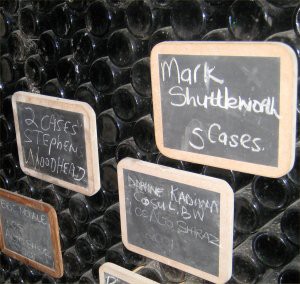 |
Wealthy people, can actually store their own wine here.
Here, Mark Shuttleworth, the first African in space, has some cases in storage. |
| Standing next to the tour bus, with my authentic bottle of Stellenbosch wine.
It cost less than a fiver, and drunk later that evening. They have a web site, and when finances pick up, I’m going to order another and have it flown over !. |
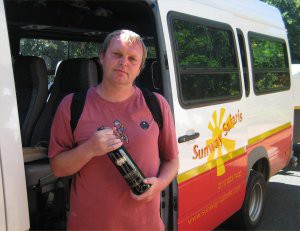 |
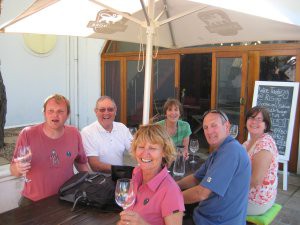 |
Our next stop is a vineyard called Knorhoek.
Outdoors this time, it had an open air party feel. £1.50 for 5 wines. Our guide this time, asked if she could give us a 6th for free. As we leave Stellenbosch, I realise that I haven’t seen the university or any of Cape Dutch architecture. |
| Our guide Charl points out this hills. When the Afrikaners left to set up the orange free state, they actually had to dig out these roads and paths, to get over the mountains.
We stop at a shopping centre to get some lunch. A security guard with an automatic pistol and AK47 is standing in the foyer. Strange, as everyone around looked happy and comfortable (perhaps that’s why 🙂 I read in my guidebook that there is a famous zoo nearby and I ask to visit it. The Adventure Company stipulate ethical travel, so its off the agenda. Someone in the van explains that anyway, a Wolf and an Aardvark could never mate anyway. We arrive at Oudtshoorn Ostrich farm. |
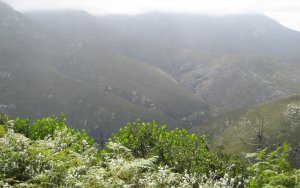 |
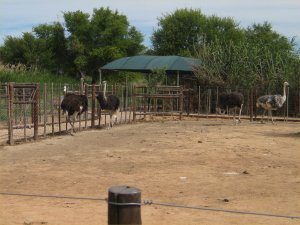 |
I hadn’t expected much from this part of the trip, but ended up fascinated by the whole thing.
Our highly enthusiastic guide, showed us a DVD of how Ostriches are farmed. It basically involves removing eggs (the Ostrich doesn’t mind, as long as their are a few left) and taking them to an incubator. Amazingly, the Ostrich will actually compensate, by having more eggs. This artificial increase, is the key to the process. Its an amazing way to farm meat, in a warm arid environment. |
| A few of the interesting things I found out:
An Ostrich can move its throat to the side or back of its neck to protect its windpipe. The Ostriches have tags to stop in-breeding. One Ostrich egg is enough for 15 people. 12% of ostriches are infertile. Farmed this way, an Ostrich egg is “good for meat” in 14 months. Eggs are very strong, but this is mainly down to the fluid inside and the sand normally found at its base. |
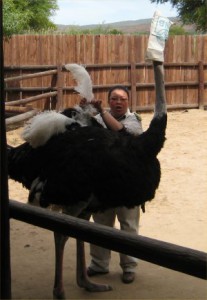 |
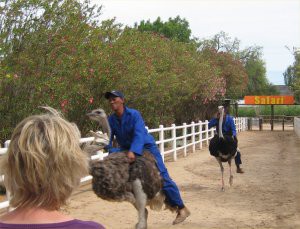 |
The excellent presentation, finished with a rather silly “donkey derby” type race with Ostriches.
We leave the Ostriches and head back to the van. Its spontaneously decided that we should visit the Cango caves. |
| We are introduced to our guide Ilse. She shows us around the 1st chamber, which is easily the biggest open area, I have ever seen underground.
The lights are dimmed, to simulate what it would be like, lit with only 1 candle, to view it as its first discoverers had. The 2nd chamber was smaller, but well worth the visit, and the 3rd, had not had its floor levelled, so we could see what it would have been like to “walk” around the others before they were finished. |
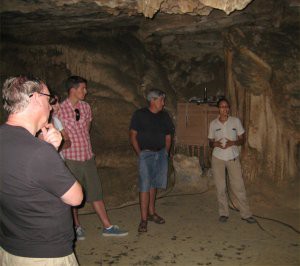 |
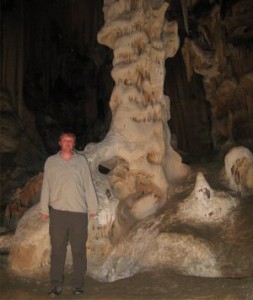 |
Some years earlier, the caves had been used for a rock concert. It was pointed out, that this would never be repeated as several priceless pieces of rock had been vandalized by thieves.
It wouldn’t have mattered if their consciences had made them return them as they could never be re-connected to the original stone. The Stalactites like this one, had been both Carbon and Uranium dated. I know some people get claustrophobic, but I absolutely love being underground in places like this. |
| In the evening we go to back to our chalets, and have an indoor bbq, cooked by Charl.
The food is delicious, and after some thought, I decide not to risk my wine on the plane, and share it with everyone. In the morning, I avoid the communal breakfast, and instead make some hot chocolate, and sit quietly on the grass. As we load up the van, everyone compliments me on how lightly I pack. I explain that I wear Rohan clothing. |
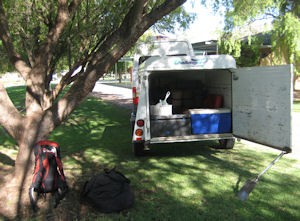 |
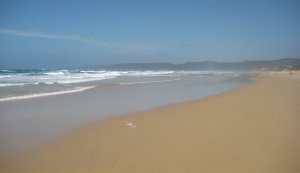 |
We stop at a beach called heaven. Charl explains that its famous for some reason and where it gets its name. Lost in the moment, so didn’t remember any of it (sorry).
We have 2 hours to relax on the beach. A few people go for a swim. Others kick a football around. I walk along the beach with Simon and Gill. It stretches out for miles. The ocean, the sky and the sand under my bare feet made for a remarkable experience. |
| We arrive at Knysna (pronounced nysna). Driving around the lagoon we get the first glimpse of our accommodation.
I always wanted to stay in a log cabin. I sort of thought I would be in Norway or Sweden, not South Africa, when it finally happened !. Quite small but had a chacuzzi, and a balcony (which I later decide to sleep on). |
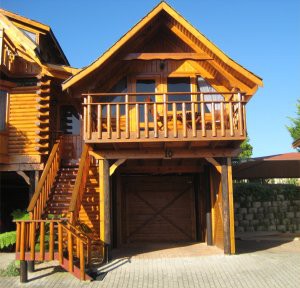 |
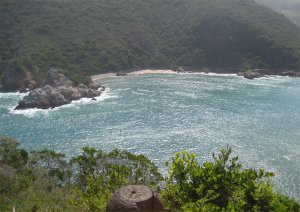 |
We walk to the famous Knysna heads.
The lake in Knysna was the inspiration for the lagoon sea battle at the end of Wilbur Smiths Blue horizon. I find a small cafe next to the water and have a coffee, enjoying this amazing view. I still couldn’t get over how inexpensive everything was. |
| An amazing site and probably the worlds most dangerous port due to tides (the saltwater ocean meets the freshwater feed, right in the middle of the lake).
On the other side of the heads is a nature reserve called Featherbed. There was a debate about whether we should visit it. At £26 I thought it was too expensive. |
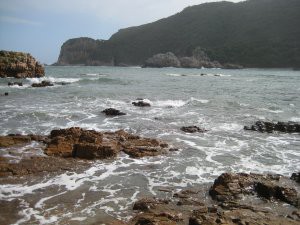 |
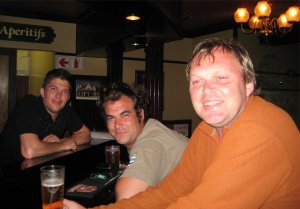 |
There’s a nice pub near our cabin so I stop by for a pint (its around 5pm and the pub is filling with after work drinkers)
The sight of people smoking really surprised me (the smoking ban in the UK has been in force for several years). I’m joined by our guide Charl, who I’ve mentioned a few times before. A really cracking bloke, I learned loads of useful and interesting things from him (and he looked like Rob from Woodsmoke). He was also a keen Wilbur Smith fan, and we frequently discussed which was his best work. One thing we did agree on, was his most recent book Assagi was awful, and reads like a Mills & Boon 🙁 There used to be a song in a tedious TV program in the UK, called Spitting Image. The song said something about, I’ve never met a nice South African. Well, that just wasn’t my experience at all. The people I met were all friendly and personable. The thing I did notice, was they were practical, plain speaking and would stand for no nonsense. I think that may be where the cultural misunderstanding comes from. |
| I wander into town to buy some souvenirs. I stop at a cyber cafe, grab a bottle of beer and catch up on my e-mail. Henrik, Nadiah and my brother David have all e-mailed me with congratulations about completing the bluelist.
I arrive early for dinner at the fisherman’s rest. A charming waitress called Melinda shows me to my table, as the other members of my group arrive. In the guidebook, its says 2 things you must try on the Garden Route are eating freshly caught fish, and drinking Mitchell’s bear. I decide its time for the first one. Back home, its normally cod or haddock, but here its hake and served in a skillet, its delicious. |
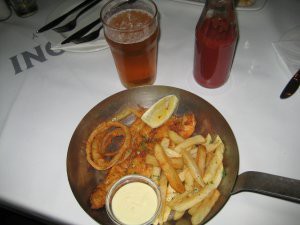 |
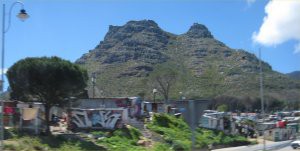 |
We never get to visit a traditional township.
The closest I got, was when we drove passed one, and I quickly took this photo. |
Capetown and the Garden Route. Finale of the Bluelist (1/3).
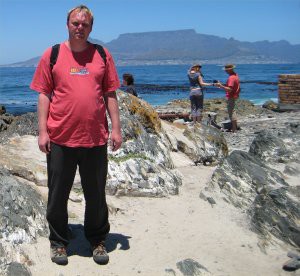 |
2002 was a very difficult time in my life. I had lost everything and was forced to sleep on the floor while I saved up to buy a bed.
The advantage to this, was I had plenty of free time, which I used to plan my goals once life improved. Significant in this, was a bluelist. Taken from the Lonely Planet book of the same name. It means roughly a list of things to do and see before you die. In 2009 with only one significant goal left out of nearly 3000. To stand on Table mountain. Having already visited 56 countries, I pick up my rucksack and head for Capetown. |
| I arrive at midnight, after flying with the excellent KLM.
Going through customs, I have a funny thought. Next time I have a passport photo taken, I will take it at 4am in the morning, so my picture reflects how I actually look when I get of a long haul flight. Its an organised tour, so I’m picked up and arrive at the Sweet Orange guesthouse 40 minutes later. I’m shown to my beautiful room, which will be my home for the next 3 nights. Wasn’t sure whether to lock my widows, so discussed security with the owner. Its very safe here he replies. Pressed further on the matter he replies. I was mugged once and I saw 2 vicious pub brawls. Oh, he interposes sarcastically, that was when I was at the Leeds University in your country !. A quick shower, a bottle of beer from the honesty box, I update my diary and then drift off to sleep. |
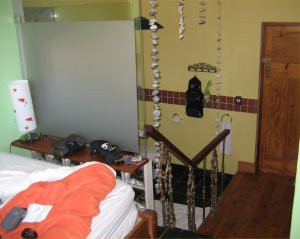 |
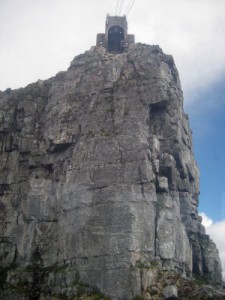 |
The trip formally started at 2pm, so I used the free time to read, update some things on my Acer netbook, check my gear etc.
The usual meet up. The group and leader arrive (a big bear of a man). The usual meet up. Hand over insurance documents, nok details and in country payment. We are all introduced to each other. Ten minutes to get ready, and were off to Table mountain. I learn that the mountain is closed frequently due to weather. It was decided we would get the cable car up, and walk down (if your at the bottom and they close it, you cant go up, but if your already on the top, they can’t stop you walking down). The cable car (sponsored rather ostentatiously by Barclaycard) normally rotates to give 360% views of the mountain. When the driver pulled the lever, nothing happened. After a few minutes, he said simply its not working today. |
| And there I was, standing on the top of Table Mountain, the culmination of 6 years pursuit of adventure.
Following an uncompromising life of adventure, has its costs, but at that moment, I felt that they had all been worth it. I looked around the souvenir shop, but just couldn’t find anything to really capture the moment. I text Amelia, Danny and Brenda with this photo. What can I say. I didn’t really feel euphoric, I just felt a sort of relief and subdued satisfaction. |
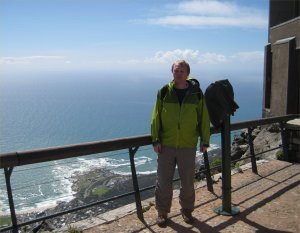 |
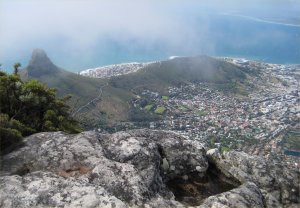 |
In a reflective mood, I wandered around the mountain top.
Here you can see the famous Lions head and Lions rump. Many Capetonians walk up the Lions head, each morning before work. I found somewhere quiet, sat quietly and read excerpts from Power of the Sword, the Wilbur Smith novel that takes place on Table mountain and had inspired this visit, 20 years previously. Since the bluelist was now technically complete, I could get on with enjoying my holiday. |
| I got to know some of my fellow travelers, as we walked back down the platteklip gorge.
Our guide Charl taught me some Afrikaans, with emphasis on pronunciation. Windhoek for example is pronounced Vindhook. I had read that crime was common while on the mountain. Another example of the paranoia myth attached to Capetown (the only people we met on the path were other walkers, and some local actors dressed as tribesmen !). Standard precautions re theft and personal safety, were all that were needed throughout the trip. Signs everywhere, say that you shouldn’t pick flowers (there are more species of plant and flower on Table Mountain than there are in the whole of the UK). A particular type of the Blue Dasai, grows only on table mountain. I took one, and have it sealed in a key ring at home. Symbolic of completing the bluelist, its priceless to me. |
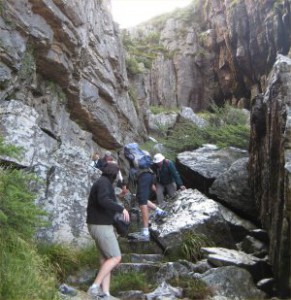 |
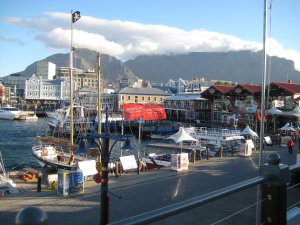 |
In a reflective mood, we walk back to the hotel and get cleaned up.
In the evening, we head out to the VA waterfront with its vibrant atmosphere and friendly bars. I’m delighted when the group choose to visit a steak house (strangely named Red Cod). I have to be careful with my budget, but decide that after the events of the day, a meal fit for a king, is appropriate. Mushroom soup to start, an enormous steak for main, a bottle of South African Red and coffee for after’s (I don’t usually eat cake). Including a tip and some money for the opera singers who serenaded us during our meal, there was change from £20. A long but massively rewarding day over, I head back to the hotel. Just before bed, I update my blog with news of the days achievement. |
| Next day, up early, for a breakfast.
Served on one big table in the middle of the room. I try Yoghurt pancakes and my usual travel staple of buttered crusty bread and coffee. Today we are driving around False bay and our first stop is Seal Island. A different boat sets off every half hour. Bellow decks, they have a glass bottom, to watch the fish. Although mostly financed by tourism, its still a working fishing port, and there were stalls around selling all kinds of exotic fish (which were obviously dead). |
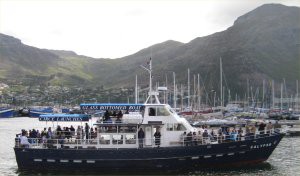 |
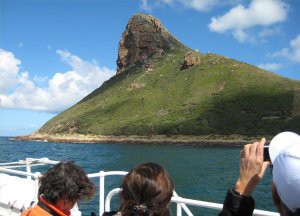 |
Although I succumb to sea sickness, there really is no pleasure like sitting on a boat being rocked by the ocean.
We sail around this hill, called the Sentinel (a prominent site from Chapman’s peak drive). |
| As we round the bend, we get our first glimpse of Seal Island.
Not so much an Island as a rock, it was packed to the rafters with seals. I expected some of them to swim over for food thrown from the boat, but they barely looked up. |
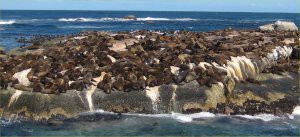 |
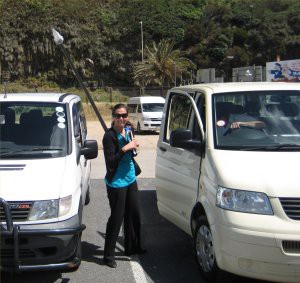 |
We tell it how it really is here at johnsunter.com
The startled girl in the picture, has reason for concern. The street lamp behind, had just been knocked over by her husband/boyfriend, who was screaming and shouting (obviously blaming her, for not spotting it first). She seemed to find it hilarious and as I walked past, and it was all I could do not to start laughing. |
| We continue along Chapman’s peak drive and see some of the spectacular views around false bay.
You can see why the Garden Route, is so popular as a fly/drive destination. |
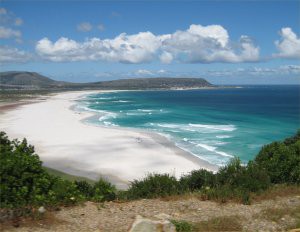 |
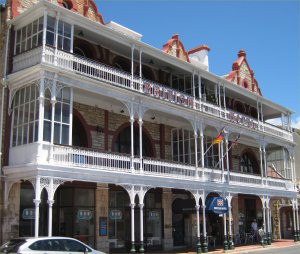 |
We visit Simons Town, which takes its name from Simon Van der Stel, the Dutch Governor of the Cape colony from 1677 to 1699.
My first sights are the famous mile of Victorian houses, including this excellent backpacker hostel. Despite its heritage, the area has a very modern port. Everyone else goes for lunch. Realising I have an hour free, I head of in search of adventure. In Jubilee square, is the statue of one of the towns most famous residents. Just Nuisance, was the only dog to be officially enlisted in the Royal Navy. Beloved by his fellow sailors, he frequently traveled into Capetown on the train, to go drinking with his shipmates. In 1944, at the end of his life, he was buried with full military honours. |
| My first stop is the Simon’s Town museum. Run by volunteers, they even had the original collar belonging to, just nuisance.
In one room, a reconstruction of the Africa Station club. A very popular Pub with Naval staff, it sadly closed down, but has been completely re-created (except that they don’t have a license, and you couldn’t actually get a drink here 🙂 |
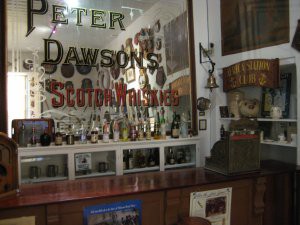 |
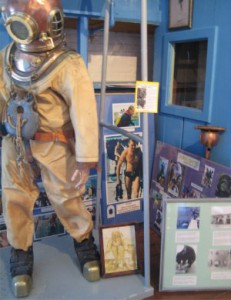 |
My next stop, is the South African Naval Museum.
They had all the stuff you’d expect in here, like uniforms and old photographs. They also had full size helicopters and a life size ships bridge. South African divers are some of the best in the world, and there were lots of diving exhibits. After an informative, whistle stop tour of both museums, I grab some fish and chips (freshly caught that morning, you don’t get that in Manchester :). |
| Just a few minutes around the corner is Boulders Beach, home to a colony of African penguins.
One of the must-see sights of the Garden Route, the surreal experience, is penguins (which you normally associate with Arctic weather conditions) on a baking hot beach. The other interesting thing is there is no record of penguins living here before 1985, and nobody seems to know why they settled here. |
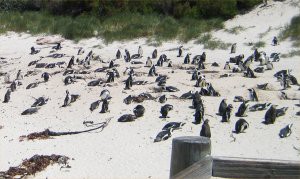 |
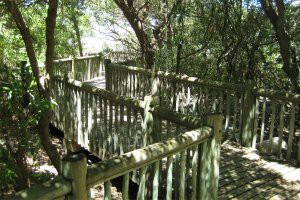 |
There are 2 boarded walks, that lead along through the trees to the viewing point (in times gone by, you could walk around on the beach with the penguins, but hundreds of thousands of people come to see them each year so its no longer practical). |
| The Penguins sometimes rest in the shade, and for the winter months have these simple shelters made of half a plastic bottle.
While walking around, I popped in the tourist shops, and bought a souvenir key ring (I remember reading a quote by the head of tourism, while in Nepal. “don’t donate money to charities, just come here, go out to eat, drink and buy souvenirs”.) |
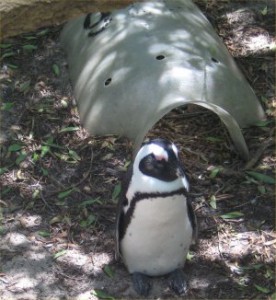 |
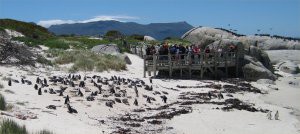 |
This photo shows one of the viewing platforms, taken from the other. You can see just how popular it is.
I really enjoyed being here, but after about 40 minutes, I had seen all the penguins, I ever wanted to. |
| Next stop, Cape Point, on the Cape of Good Hope Nature Reserve.
After table mountain, it was the place I really wanted to see. Many people mistakenly think that this is the most Southerly point in Africa. It isn’t, that’s Cape Agulhas, about 90 miles away. |
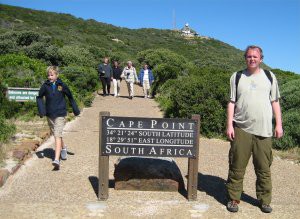 |
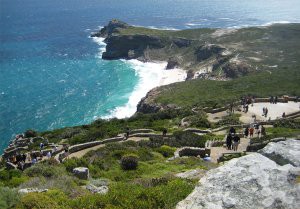 |
A common phrase used to encourage plane speaking in SA, is “you can’t swim the 2 oceans”. This comes from the meeting of the Indian Ocean and the Atlantic, which happens around this area.
There is no specific place where this happens, it varies between Cape point and Cape Agulhas. This causes unpredictable tides and currents, which is why Thousands of ships have sunk around this area in the last 100 years. It was a beautiful day and the views across the beaches were fantastic. |
| I headed straight up the hill, to the old lighthouse.
Its no longer used, and as you can see from this picture, has a “Blackpool tower” feel to it. |
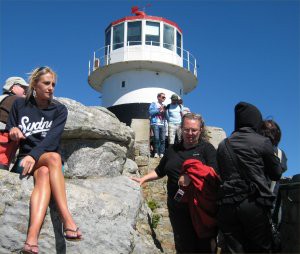 |
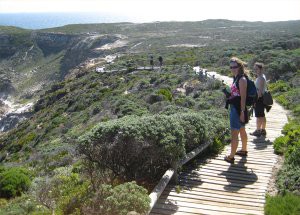 |
We take the cliff route to the actual Cape of Good Hope.
I caught up with some of the girls in the group, and off we went. The walk was boarded, so secure under foot, but howling coastal winds blew up sand, and I had to protect my eyes. I stopped at one point to enjoy the view. The cliffs I was standing on, were 800 feet above the ocean, it really was breathtaking. As I looked down onto the bays, I saw a group playing cricket. |
| At the end of the cliffs, the path drops down.
The area is known for its Fynbos vegetation, and there were loads of harmless, friendly animals, running around. |
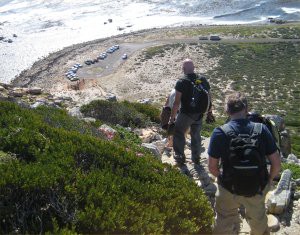 |
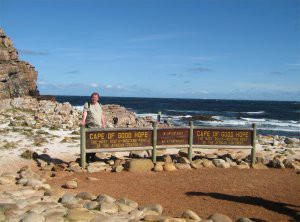 |
At the bottom and I get to stand at the Cape of Good Hope.
It had special significance for me. I remember being 13 and a PE teacher, was teaching us geography in a most uninspiring way. Typically, he used me to make an example, made me stand up and shouted at me in front of the whole class. I remember the humiliation when he told me I was scruffy and I would never “go anywhere”. The lesson was about famous Portuguese explorer Vasco de Gama setting up a spice trading route around the Cape of Good hope in 1497. If by any coincidence, your reading this Mr Blease, formerly of Moston Brook High School, I’ve actually been there. Have you ? |
